Abstract
Based on the crystal structure of HLA-A2.1 and the recognition of a panel of mutant HLA-A2.1 molecules by a large number of alloreactive cytotoxic T lymphocyte clones, a model to explain alloreactivity is described. In this model recognition of an allogeneic major histocompatibility complex molecule by a self-restricted T-cell receptor occurs as the result of accommodation by the receptor of a few amino acid differences in the major histocompatibility complex molecule--i.e., cross-recognition. Alloreactivity is the result of the presence in the foreign antigen binding site of the allogeneic major histocompatibility complex molecule of unusual self-peptides, reactivity to which could not have been eliminated by negative thymic selection.
Full text
PDF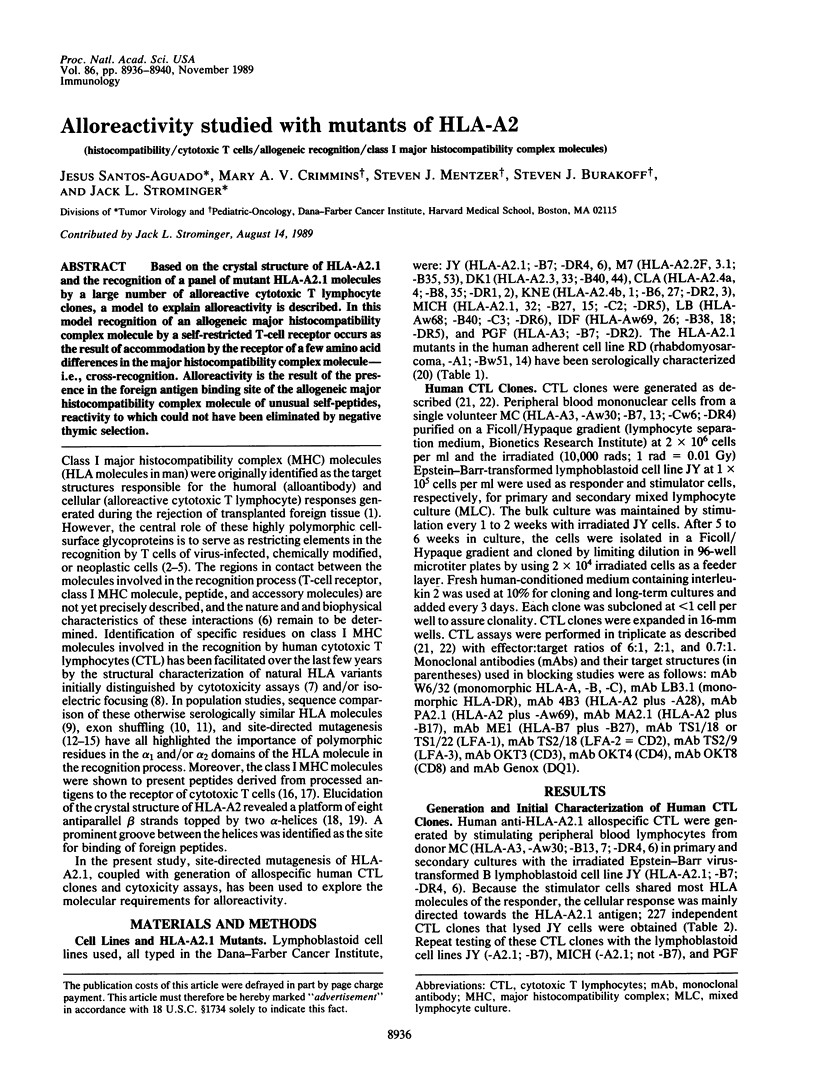
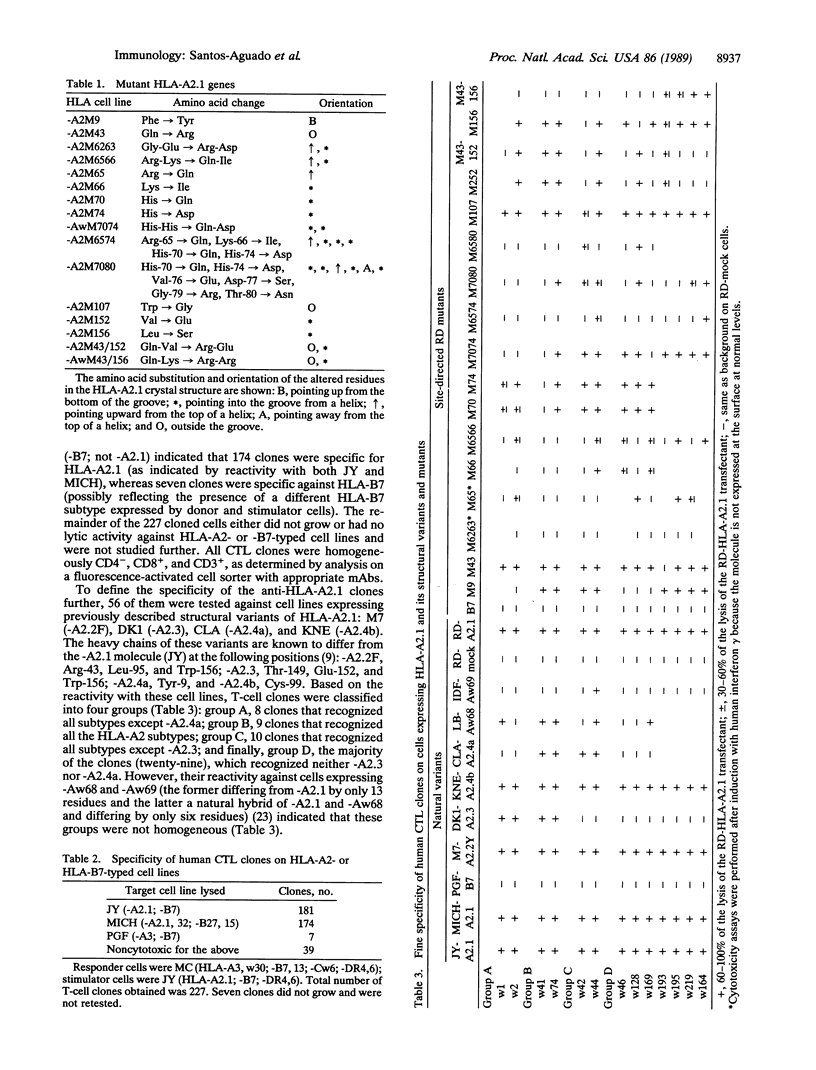
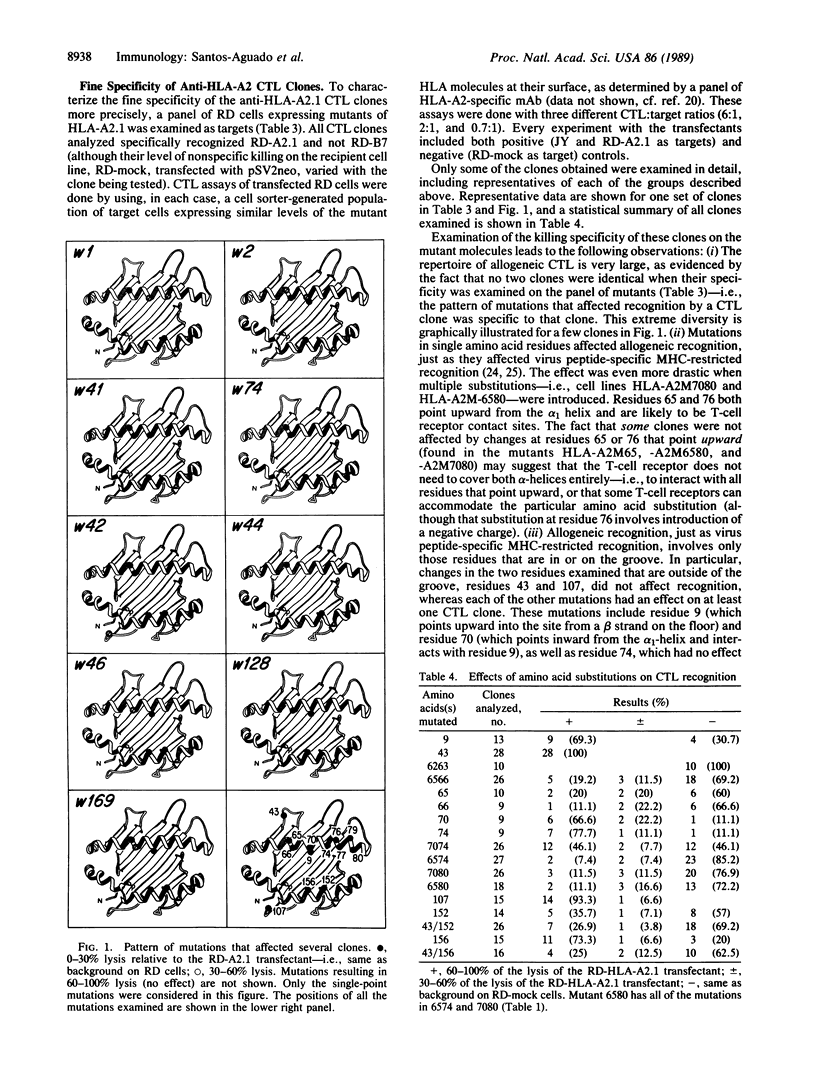
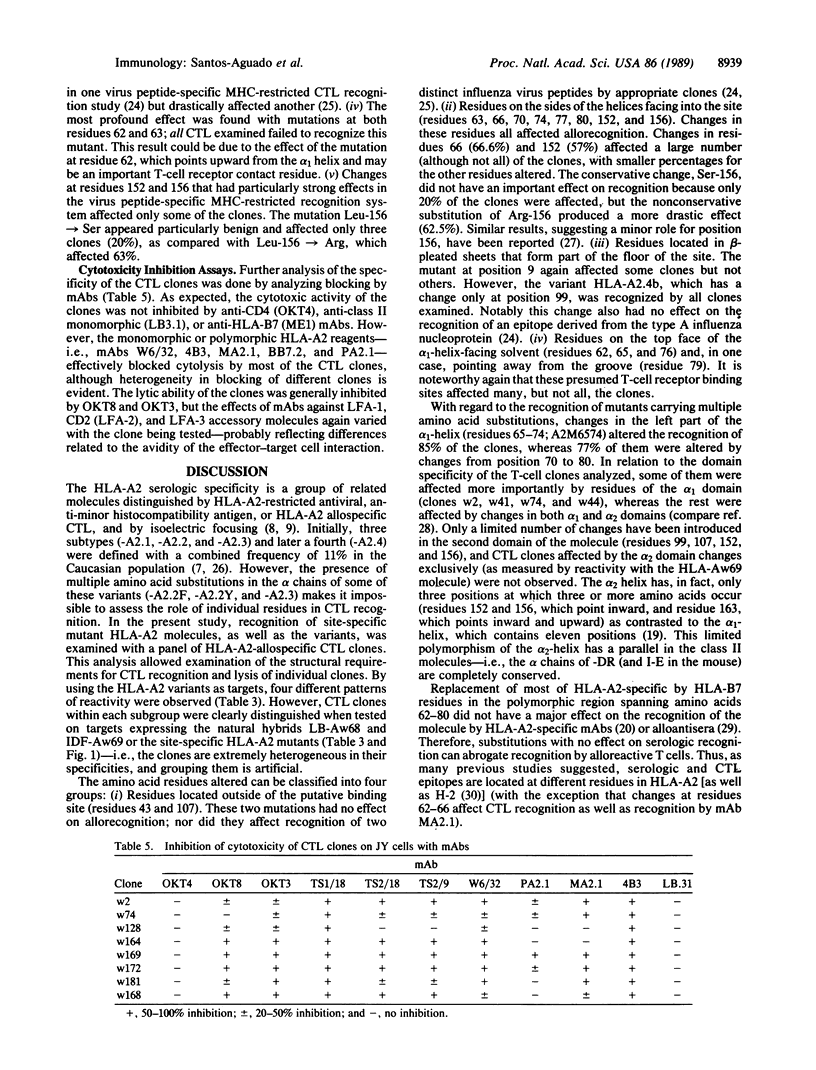
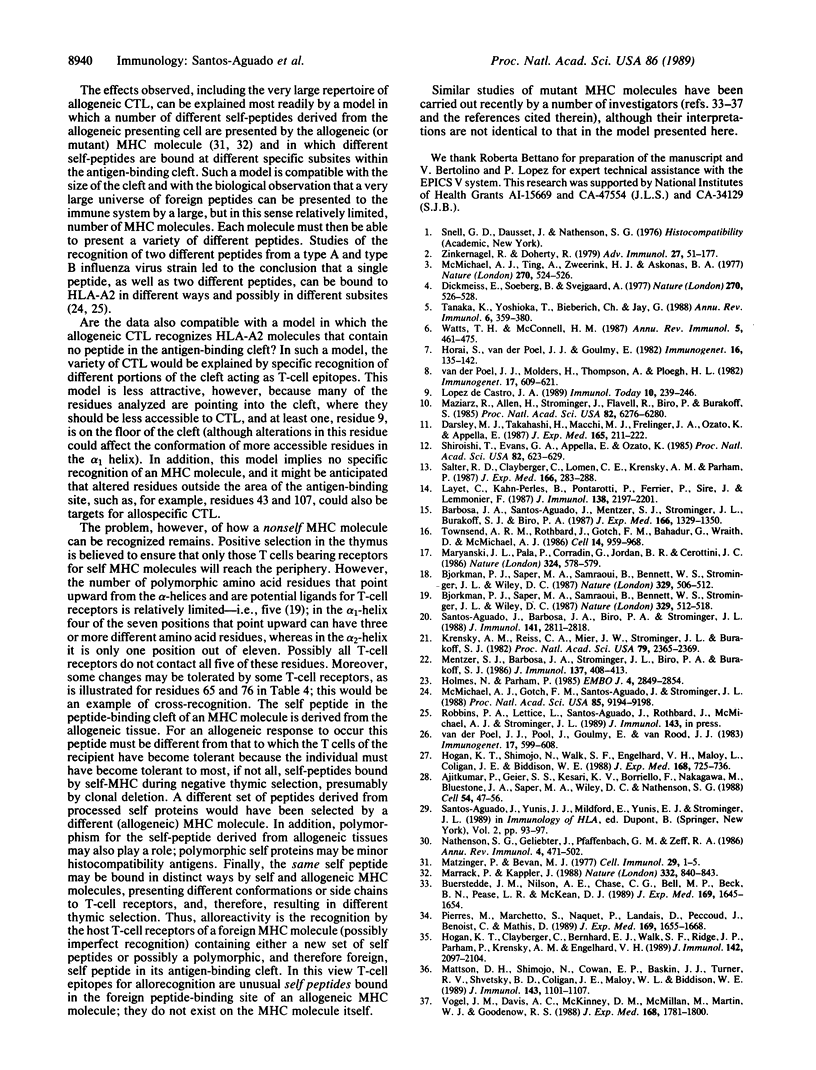
Selected References
These references are in PubMed. This may not be the complete list of references from this article.
- Ajitkumar P., Geier S. S., Kesari K. V., Borriello F., Nakagawa M., Bluestone J. A., Saper M. A., Wiley D. C., Nathenson S. G. Evidence that multiple residues on both the alpha-helices of the class I MHC molecule are simultaneously recognized by the T cell receptor. Cell. 1988 Jul 1;54(1):47–56. doi: 10.1016/0092-8674(88)90178-x. [DOI] [PubMed] [Google Scholar]
- Barbosa J. A., Santos-Aguado J., Mentzer S. J., Strominger J. L., Burakoff S. J., Biro P. A. Site-directed mutagenesis of class I HLA genes. Role of glycosylation in surface expression and functional recognition. J Exp Med. 1987 Nov 1;166(5):1329–1350. doi: 10.1084/jem.166.5.1329. [DOI] [PMC free article] [PubMed] [Google Scholar]
- Bjorkman P. J., Saper M. A., Samraoui B., Bennett W. S., Strominger J. L., Wiley D. C. Structure of the human class I histocompatibility antigen, HLA-A2. Nature. 1987 Oct 8;329(6139):506–512. doi: 10.1038/329506a0. [DOI] [PubMed] [Google Scholar]
- Bjorkman P. J., Saper M. A., Samraoui B., Bennett W. S., Strominger J. L., Wiley D. C. The foreign antigen binding site and T cell recognition regions of class I histocompatibility antigens. Nature. 1987 Oct 8;329(6139):512–518. doi: 10.1038/329512a0. [DOI] [PubMed] [Google Scholar]
- Buerstedde J. M., Nilson A. E., Chase C. G., Bell M. P., Beck B. N., Pease L. R., McKean D. J. A beta polymorphic residues responsible for class II molecule recognition by alloreactive T cells. J Exp Med. 1989 May 1;169(5):1645–1654. doi: 10.1084/jem.169.5.1645. [DOI] [PMC free article] [PubMed] [Google Scholar]
- Darsley M. J., Takahashi H., Macchi M. J., Frelinger J. A., Ozato K., Appella E. New family of exon-shuffled recombinant genes reveals extensive interdomain interactions in class I histocompatibility antigens and identifies residues involved. J Exp Med. 1987 Jan 1;165(1):211–222. doi: 10.1084/jem.165.1.211. [DOI] [PMC free article] [PubMed] [Google Scholar]
- Dickmeiss E., Soeberg B., Svejgaard A. Human cell-mediated cytotoxicity against modified target cells is restricted by HLA. Nature. 1977 Dec 8;270(5637):526–528. doi: 10.1038/270526a0. [DOI] [PubMed] [Google Scholar]
- Hogan K. T., Clayberger C., Bernhard E. J., Walk S. F., Ridge J. P., Parham P., Krensky A. M., Engelhard V. H. A panel of unique HLA-A2 mutant molecules define epitopes recognized by HLA-A2-specific antibodies and cytotoxic T lymphocytes. J Immunol. 1989 Mar 15;142(6):2097–2104. [PubMed] [Google Scholar]
- Hogan K. T., Shimojo N., Walk S. F., Engelhard V. H., Maloy W. L., Coligan J. E., Biddison W. E. Mutations in the alpha 2 helix of HLA-A2 affect presentation but do not inhibit binding of influenza virus matrix peptide. J Exp Med. 1988 Aug 1;168(2):725–736. doi: 10.1084/jem.168.2.725. [DOI] [PMC free article] [PubMed] [Google Scholar]
- Holmes N., Parham P. Exon shuffling in vivo can generate novel HLA class I molecules. EMBO J. 1985 Nov;4(11):2849–2854. doi: 10.1002/j.1460-2075.1985.tb04013.x. [DOI] [PMC free article] [PubMed] [Google Scholar]
- Horai S., van der Poel J. J., Goulmy E. Differential recognition of the serologically defined HLA-A2 antigen by allogeneic cytotoxic T cells. I. Population studies. Immunogenetics. 1982;16(2):135–142. doi: 10.1007/BF00364400. [DOI] [PubMed] [Google Scholar]
- Krensky A. M., Reiss C. S., Mier J. W., Strominger J. L., Burakoff S. J. Long-term human cytolytic T-cell lines allospecific for HLA-DR6 antigen are OKT4+. Proc Natl Acad Sci U S A. 1982 Apr;79(7):2365–2369. doi: 10.1073/pnas.79.7.2365. [DOI] [PMC free article] [PubMed] [Google Scholar]
- Layet C., Kahn-Perles B., Pontarotti P., Ferrier P., Sire J., Lemonnier F. A. Creation of an HLA-A2/HLA-Aw69 alloantigenic determinant on an HLA-A3 molecule by site-directed mutagenesis. J Immunol. 1987 Apr 1;138(7):2197–2201. [PubMed] [Google Scholar]
- López de Castro J. A. HLA-B27 and HLA-A2 subtypes: structure, evolution and function. Immunol Today. 1989 Jul;10(7):239–246. doi: 10.1016/0167-5699(89)90261-2. [DOI] [PubMed] [Google Scholar]
- Marrack P., Kappler J. T cells can distinguish between allogeneic major histocompatibility complex products on different cell types. Nature. 1988 Apr 28;332(6167):840–843. doi: 10.1038/332840a0. [DOI] [PubMed] [Google Scholar]
- Maryanski J. L., Pala P., Corradin G., Jordan B. R., Cerottini J. C. H-2-restricted cytolytic T cells specific for HLA can recognize a synthetic HLA peptide. Nature. 1986 Dec 11;324(6097):578–579. doi: 10.1038/324578a0. [DOI] [PubMed] [Google Scholar]
- Mattson D. H., Shimojo N., Cowan E. P., Baskin J. J., Turner R. V., Shvetsky B. D., Coligan J. E., Maloy W. L., Biddison W. E. Differential effects of amino acid substitutions in the beta-sheet floor and alpha-2 helix of HLA-A2 on recognition by alloreactive viral peptide-specific cytotoxic T lymphocytes. J Immunol. 1989 Aug 15;143(4):1101–1107. [PubMed] [Google Scholar]
- Matzinger P., Bevan M. J. Hypothesis: why do so many lymphocytes respond to major histocompatibility antigens? Cell Immunol. 1977 Mar 1;29(1):1–5. doi: 10.1016/0008-8749(77)90269-6. [DOI] [PubMed] [Google Scholar]
- Maziarz R., Allen H., Strominger J. L., Flavell R., Biro P. A., Burakoff S. J. Recognition of interspecies hybrid class I histocompatibility antigens by antigen-specific cytolytic T lymphocytes. Proc Natl Acad Sci U S A. 1985 Sep;82(18):6276–6280. doi: 10.1073/pnas.82.18.6276. [DOI] [PMC free article] [PubMed] [Google Scholar]
- McMichael A. J., Gotch F. M., Santos-Aguado J., Strominger J. L. Effect of mutations and variations of HLA-A2 on recognition of a virus peptide epitope by cytotoxic T lymphocytes. Proc Natl Acad Sci U S A. 1988 Dec;85(23):9194–9198. doi: 10.1073/pnas.85.23.9194. [DOI] [PMC free article] [PubMed] [Google Scholar]
- McMichael A. J., Ting A., Zweerink H. J., Askonas B. A. HLA restriction of cell-mediated lysis of influenza virus-infected human cells. Nature. 1977 Dec 8;270(5637):524–526. doi: 10.1038/270524a0. [DOI] [PubMed] [Google Scholar]
- Mentzer S. J., Barbosa J. A., Strominger J. L., Biro P. A., Burakoff S. J. Species-restricted recognition of transfected HLA-A2 and HLA-B7 by human CTL clones. J Immunol. 1986 Jul 15;137(2):408–413. [PubMed] [Google Scholar]
- Nathenson S. G., Geliebter J., Pfaffenbach G. M., Zeff R. A. Murine major histocompatibility complex class-I mutants: molecular analysis and structure-function implications. Annu Rev Immunol. 1986;4:471–502. doi: 10.1146/annurev.iy.04.040186.002351. [DOI] [PubMed] [Google Scholar]
- Pierres M., Marchetto S., Naquet P., Landais D., Peccoud J., Benoist C., Mathis D. I-A alpha polymorphic residues that determine alloreactive T cell recognition. J Exp Med. 1989 May 1;169(5):1655–1668. doi: 10.1084/jem.169.5.1655. [DOI] [PMC free article] [PubMed] [Google Scholar]
- Salter R. D., Clayberger C., Lomen C. E., Krensky A. M., Parham P. In vitro mutagenesis at a single residue introduces B and T cell epitopes into a class I HLA molecule. J Exp Med. 1987 Jul 1;166(1):283–288. doi: 10.1084/jem.166.1.283. [DOI] [PMC free article] [PubMed] [Google Scholar]
- Santos-Aguado J., Barbosa J. A., Biro P. A., Strominger J. L. Molecular characterization of serologic recognition sites in the human HLA-A2 molecule. J Immunol. 1988 Oct 15;141(8):2811–2818. [PubMed] [Google Scholar]
- Shiroishi T., Evans G. A., Appella E., Ozato K. In vitro mutagenesis of a mouse MHC class I gene for the examination of structure-function relationships. J Immunol. 1985 Jan;134(1):623–629. [PubMed] [Google Scholar]
- Tanaka K., Yoshioka T., Bieberich C., Jay G. Role of the major histocompatibility complex class I antigens in tumor growth and metastasis. Annu Rev Immunol. 1988;6:359–380. doi: 10.1146/annurev.iy.06.040188.002043. [DOI] [PubMed] [Google Scholar]
- Townsend A. R., Rothbard J., Gotch F. M., Bahadur G., Wraith D., McMichael A. J. The epitopes of influenza nucleoprotein recognized by cytotoxic T lymphocytes can be defined with short synthetic peptides. Cell. 1986 Mar 28;44(6):959–968. doi: 10.1016/0092-8674(86)90019-x. [DOI] [PubMed] [Google Scholar]
- Vogel J. M., Davis A. C., McKinney D. M., McMillan M., Martin W. J., Goodenow R. S. Molecular characterization of the C3HfB/HeN H-2Kkm2 mutation. Implications for the molecular basis of alloreactivity. J Exp Med. 1988 Nov 1;168(5):1781–1800. doi: 10.1084/jem.168.5.1781. [DOI] [PMC free article] [PubMed] [Google Scholar]
- Watts T. H., McConnell H. M. Biophysical aspects of antigen recognition by T cells. Annu Rev Immunol. 1987;5:461–475. doi: 10.1146/annurev.iy.05.040187.002333. [DOI] [PubMed] [Google Scholar]
- Zinkernagel R. M., Doherty P. C. MHC-restricted cytotoxic T cells: studies on the biological role of polymorphic major transplantation antigens determining T-cell restriction-specificity, function, and responsiveness. Adv Immunol. 1979;27:51–177. doi: 10.1016/s0065-2776(08)60262-x. [DOI] [PubMed] [Google Scholar]
- van der Poel J. J., Mölders H., Thompson A., Ploegh H. L. Definition of four HLA-A2 subtypes by CML typing and biochemical analysis. Immunogenetics. 1983;17(6):609–621. doi: 10.1007/BF00366129. [DOI] [PubMed] [Google Scholar]
- van der Poel J. J., Pool J., Goulmy E., van Rood J. J. Differential recognition of the serologically defined HLA-A2 antigen by allogeneic cytotoxic T cells. II. Definition of three HLA-A2 subtypes by CTLs. Immunogenetics. 1983;17(6):599–608. doi: 10.1007/BF00366128. [DOI] [PubMed] [Google Scholar]


